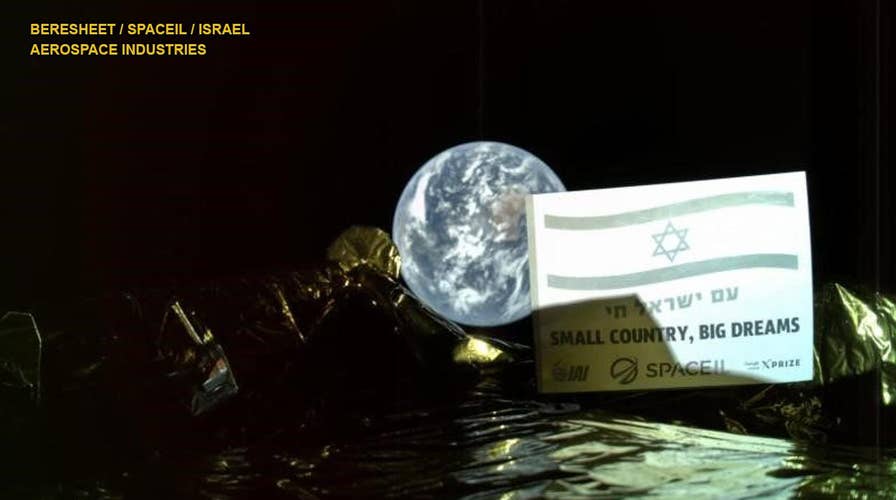Israeli spacecraft snaps stunning selfie on its way to the Moon
The unmanned Israeli spacecraft, Beresheet, captured a stunning selfie when the spacecraft was 23,364 miles from Earth. The spacecraft was developed by the Israeli nonprofit SpaceIL and the state-owned Israel Aerospace Industries. Beresheet was launched from Cape Canaveral Air Force Station atop a SpaceX Falcon 9 rocket on February 21, and is expected to reach the lunar surface on April 11.
Israel’s unmanned Beresheet spacecraft has captured a stunning selfie on its historic journey to the Moon.
The photo was taken when the probe was 37,600 kilometers (23,364 miles) from Earth, SpaceIL tweeted Tuesday. “At a distance of 37,600 km from Earth, #Beresheet’s selfie camera took a picture of #Earth. Australia can be clearly seen! This photo was taken during a slow spin of the #spacecraft & for the first time see the Israeli flag & text “am yisrael chai.”
“Am yisrael chai” translates as “long live the nation of Israel,” The Jerusalem Post reported.
ISRAEL’S FIRST MOON LANDER LAUNCHES ON SPACEX ROCKET
Beresheet, which is the Hebrew word for “beginning,” was developed by the Israeli nonprofit SpaceIL and the state-owned Israel Aerospace Industries.
The spacecraft was launched from Cape Canaveral Air Force Station atop a SpaceX Falcon 9 rocket on Feb. 21. The lander is expected to reach the lunar surface on April 11.
Last week, Beresheet encountered a technical glitch on its voyage to the Moon. Engineers at SpaceIL said that the onboard computer system unexpectedly reset, canceling a maneuver that would keep the small spacecraft on track for its April landing.
30-MILLION-PAGE ARCHIVE OF HUMANITY'S ACHIEVEMENTS HEADED TO THE MOON
SpaceIL said that scientists examined the computer resets and implemented “corrective measures,” with Beresheet conducting a successful maneuver on Feb. 28. The spacecraft’s main engine was activated for four minutes.
After reaching the lunar surface, the spacecraft will take Israel into a select group of nations. Only three countries – the U.S., the Soviet Union and China – have made successful ‘soft landings’ on the Moon. An Indian impact probe was intentionally crashed into the lunar surface in 2008. The following year, Japan’s Kaguya spacecraft was directed to crash into the Moon.
On its winding journey, Beresheet is expected to slingshot around the Earth at least six times. Beresheet also will be the first private mission to reach Earth’s natural satellite.
'THERE WAS A BIT OF TENSION': ASTRONAUT DESCRIBES WATCHING MOON LANDING WITH BUZZ ALDRIN’S FAMILY
The spacecraft was born out of the Google Lunar XPRIZE competition to land an unmanned probe on the Moon. The $30 million competition was scrapped with no winner last year after the organizers said none of the five finalists would make the March 31, 2018 deadline for a Moon launch, Space.com reported.
Nonetheless, the Israeli team pressed on with the development of its 397-pound spacecraft.
After its two-month journey, the probe will land within Mare Serenitatis in the Moon’s northern hemisphere. SpaceIL notes that the site has magnetic anomalies, enabling Beresheet’s magnetometer device to take measurements as part of a scientific experiment. Data from the magnetometer, which was developed with Israel’s Weizmann Institute of Science, will be shared with NASA.
ASTRONAUT DESCRIBES WATCHING THE MOON LANDING WITH PRESIDENT NIXON IN THE WHITE HOUSE
In addition to its science mission, Beresheet is also taking a 30-million page archive of humanity’s achievements to the Moon. Beresheet and its time capsule will remain on the lunar surface indefinitely.
The Moon looms large for a number of countries’ space programs. China, for example, recently became the first country to successfully land a probe on the far side of the Moon when the Chang’e 4 lander reached the lunar surface on Jan. 2.
The U.S. also has its sights set on the celestial satellite. President Trump wants U.S. astronauts to return to the Moon as a foundation for future Mars missions and the administration has cited Moon missions as a key element of the 2019 NASA budget. As part of the recent bill to fund the government through the end of fiscal 2019, NASA is getting $21.5 billion, an increase over 2018's budget request.
APOLLO 8 ASTRONAUTS RECOUNT NASA'S EPIC FIRST MISSION TO THE MOON
In a speech last year, Vice President Mike Pence discussed plans for a Lunar Orbital Platform-Gateway, a NASA orbital outpost that will be in the vicinity of the Moon. The chair of the National Space Council described the goal of putting an American on board the Lunar Orbital Platform before the end of 2024. “We’re on the cusp of a new golden age of exploration,” Pence said.
NASA released a draft Request for Proposals last year that called on the U.S. commercial space industry help deliver payloads to the Moon. Unmanned contract missions to the lunar surface are expected to begin as early as 2019, it said. The government space agency has a goal to send a manned mission to Mars in the 2030s.
CLICK HERE TO GET THE FOX NEWS APP
The last time a human set foot on the Moon was during the Apollo 17 mission in December 1972. Only 12 men, all Americans, have set foot on the Moon.
Fox News’ Christopher Carbone and the Associated Press contributed to this article.
Follow James Rogers on Twitter @jamesjrogers




















